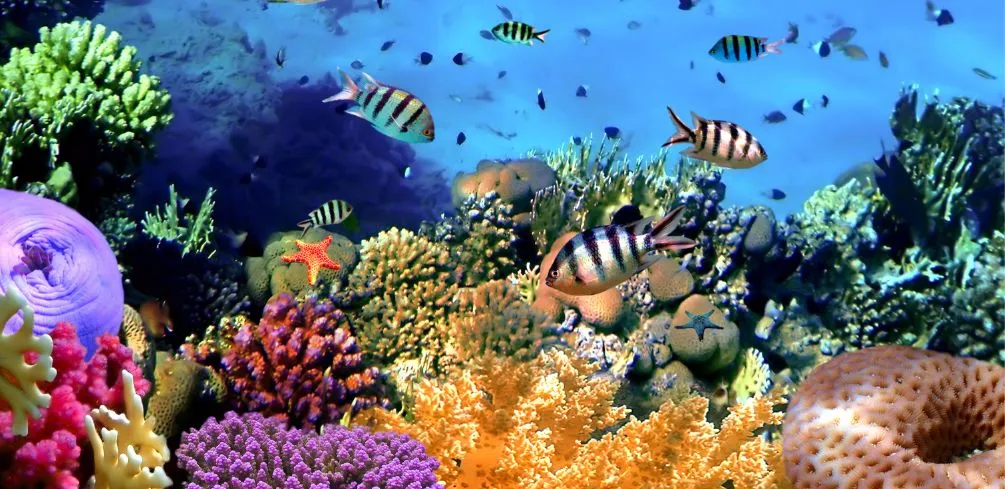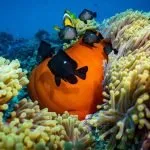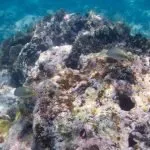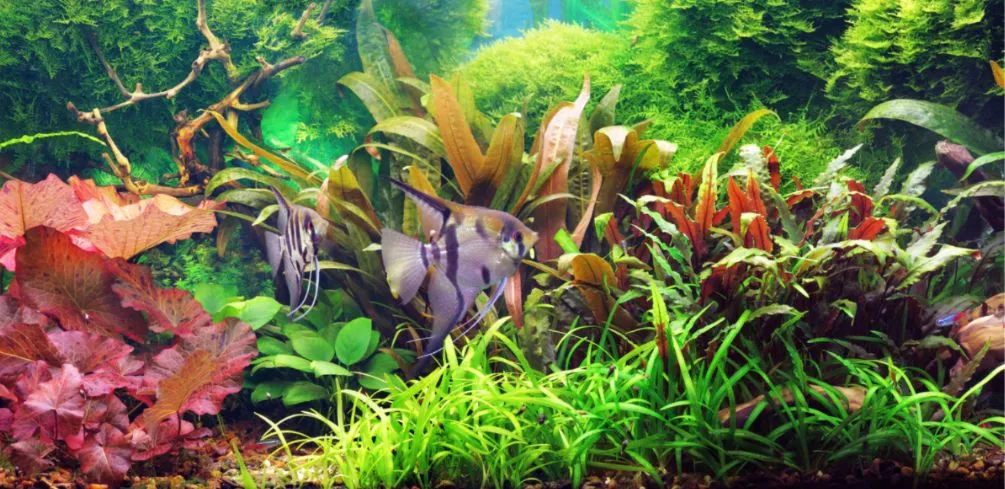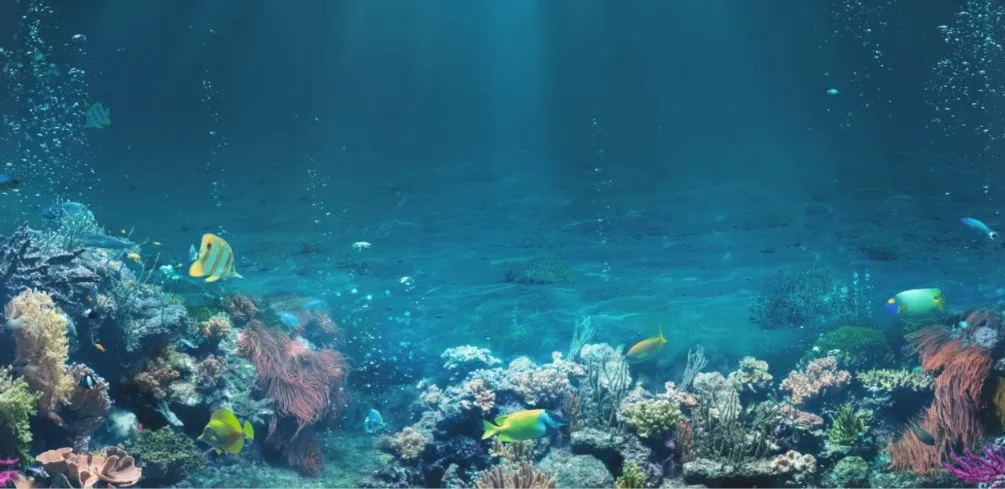The ocean is home to an incredible variety of marine life, and one of the most important aspects of their environment are coral reefs. But what is it that makes coral reefs so important? In this article, we’ll explore the many benefits that coral reefs bring to marine life.
First of all, coral reefs provide essential habitats for many species of fish, invertebrates, and other organisms. By providing food, shelter, and a place to breed, coral reefs create a safe haven for these creatures that would otherwise struggle to survive in open waters. The biodiversity of coral reef ecosystems also helps keep the entire ocean healthy by maintaining food webs and nutrient cycles.
Secondly, coral reefs can act as natural barriers against storms and waves that might otherwise damage coastal communities. By dissipating wave energy before it reaches shorelines, corals can protect nearby land from flooding or erosive processes. This protection also extends to local seagrass beds, which are vital sources of food and habitat for many fish species.
By now, you’ve probably realized just how beneficial coral reefs are for marine life! In the following sections, we’ll go into further detail about why they’re so important and how we can help protect them from human-induced threats.
Overview Of Coral Reefs
It’s a widely accepted notion that coral reefs are vital to the health of our oceans. But what exactly is it about these underwater ecosystems that makes them so important? To answer this, we must first understand what coral reefs are and how they support marine biodiversity.
Coral reefs are formed by colonies of tiny animals called coral polyps, which live together in warm, shallow waters and secrete calcium carbonate to form the structures we know as coral.
These colonies can grow to form huge, complex structures in the ocean, providing a habitat for thousands of species – from fish and sea turtles to crustaceans, sponges, and even other types of corals. In this way, coral reefs act as powerful hubs for ocean biodiversity, making them essential for healthy marine life.
Not only do coral reefs support an incredible range of species, but they also play a crucial role in protecting shorelines from strong waves and storms. By absorbing wave energy, they act as a buffer against flooding and coastal erosion- further demonstrating their importance for ocean health.
Coral reefs may seem like small pieces of our planet’s puzzle – but their impact on marine life is undeniable. From supporting biodiversity to protecting coastlines, these underwater ecosystems have an invaluable role in keeping our oceans healthy – no matter how small they may be.
Ecological Significance For Marine Life
Moving from the previous section on the Overview of Coral Reefs, I will now discuss the ecological significance for marine life. Coral reefs provide a vast array of benefits for the creatures living in them. They are home to numerous species and create an environment with a great deal of complexity and biodiversity conservation.
Coral reefs offer protection from predators and shelter from storms. The presence of coral also helps to reduce wave action, which can benefit fish, invertebrates, and other organisms that inhabit the reef habitat. In addition, they provide food sources such as small crustaceans and plankton, which are essential for many types of fish and other marine creatures.
Not only do coral reefs give shelter to different marine species, but they also help to maintain healthy populations of these species by providing a protected breeding ground. This is critical for maintaining biodiversity since many species rely on healthy habitats in order to reproduce successfully. Furthermore, because coral reefs are so intricately connected with each other, they create a unique ecosystem where different species interact with each other in ways that would not be possible without the presence of coral reefs.
In conclusion, coral reefs have immense ecological significance for marine life due to their complex habitats, protection against predators and storms, food sources for various species, and ability to support diverse populations. These important benefits make coral reefs integral components of our ocean’s health and should be given due consideration when making decisions about how best to conserve them.
Nutrient Sources And Food Webs
I’m sure you’re aware of the fact that coral reefs are essential for the ocean’s delicate balance. But did you know that they provide a variety of nutrient sources and food webs for marine life? Let me explain how coral reefs help in this regard:
Nutrient Sources:
- Coral reefs act as a source of nutrients for marine life, providing them with substances such as nitrogen and phosphorous.
- These substances are essential for the growth and maintenance of fish and other aquatic creatures, which rely on them to stay healthy and productive.
- The presence of these vital nutrients also helps support the growth of plankton and algae, which form the basis of many food webs.
Food Webs:
- Coral reefs provide an abundance of food sources for animals living in their vicinity. For example, small fish can feed on plankton or algae that grow on the reef itself, while larger animals like sharks can feed on smaller fish found near it.
- This abundance of food sources helps to create a healthy environment where different species can thrive and interact with each other. It also ensures that there is enough food available to sustain them in times when other resources are scarce.
- Furthermore, coral reefs act as a refuge for many endangered species, providing them with safe haven from predators or adverse environmental conditions.
Conservation efforts play an important role in preserving these nutrient sources and food webs provided by coral reefs. Through careful management and protection measures, we can ensure that marine life continues to benefit from these valuable ecosystems for many years to come.
Threats To Coral Reefs
The threats to coral reefs in the world’s oceans are nothing short of catastrophic. In fact, it’s almost a miracle that these incredible ecosystems still exist at all. The major threats to coral reefs include coral bleaching, ocean acidification, destructive fishing practices, pollution runoff, and climate change.
| Threats | Description | Possible Solutions |
|---|---|---|
| Coral Bleaching | Loss of color caused by warm water temperatures | Reduce water temp |
| Ocean Acidification | Increase in ocean acidity due to high levels of carbon dioxide | Reduced CO2 emissions |
| Destructive Fishing | Overfishing and use of damaging fishing methods | Sustainable fishing practices |
| Pollution Runoff | Pollutants from land entering the ocean | Improved wastewater management |
| Climate Change | Rising sea levels resulting from global warming | Reduced reliance on fossil fuels |
These threats endanger not only the coral reefs themselves but also the biodiversity of marine life they support. For example, when coral bleaching occurs, it can cause corals to die off. This can lead to a decrease in food sources for fish and other organisms living within the reef ecosystem.
Plus, with ocean acidification, there is less calcium carbonate available for corals to use, which weakens their skeletons and makes them more susceptible to damage. Furthermore, destructive fishing practices such as trawling or dynamite fishing can physically damage reefs or remove important species like fish or shellfish that provide food or shelter for other creatures living there.
Finally, pollution runoff from land-based sources can introduce hazardous chemicals into the reef environment, which can harm both corals and marine life alike.
There are ways we can help protect our precious coral reefs from these threats. Solutions include reducing water temperatures through improved conservation efforts; cutting back on CO2 emissions; implementing sustainable fishing practices; improving wastewater management; and transitioning away from reliance on fossil fuels for energy production.
By taking action now, we have an opportunity to safeguard one of Earth’s most important ecosystems for generations to come.
Conservation Efforts
The threats to coral reefs are numerous, but fortunately, there are many conservation efforts underway to protect and restore these vital marine ecosystems. From local initiatives to international agreements, the world has taken steps toward coral reef conservation and marine conservation in general.
The most basic level of coral reef protection is through local efforts such as beach cleanups and educational programs. These initiatives can help raise awareness about the importance of coral reefs and motivate people to take action for their preservation. Additionally, local organizations can work with local governments on policies that protect coral from overfishing or pollution.
On a larger scale, international organizations such as the United Nations have adopted ocean conservation policies to reduce the impact of climate change on coral reefs. These policies may include regulations on fishing or restrictions on emissions from ships in order to protect the ocean environment.
Additionally, research institutions have partnered with non-profits to develop new methods for restoring damaged reefs or propagating healthy ones. These efforts involve activities such as selective breeding, replanting corals, or introducing new species into a reef system.
By combining education and policymaking with science-based restoration techniques, we can ensure the future health of our oceans and their inhabitants by preserving fragile coral reefs. Through these combined efforts, we can continue to enjoy their beauty while also protecting them for generations to come.
Frequently Asked Questions
What Types Of Coral Reefs Are There?
Coral reefs are amazing ecosystems that are home to a wide variety of marine life. They provide shelter, nutrition, and breeding grounds for fish and other marine creatures. There are many different types of coral reefs, each with its own unique characteristics. Let’s take a look at the five main types: deep-water coral, branching coral, stony coral, soft coral, and fire coral.
Deep-water corals live in depths of over 130 feet (40 meters). They are often found near continental shelves where they can receive plenty of nutrients from the ocean currents. These corals come in various shapes and sizes but often look like delicate trees with branches stretching toward the surface.
Branching corals have multiple branches which grow upwards from their bases. These corals can be found in shallow waters or as deep as 130 feet (40 meters). They provide homes for numerous species of fish and other aquatic animals, such as shrimp and crabs.
Stony corals form hard structures made up of calcium carbonate skeletons which serve as homes for small fish and invertebrates. These corals don’t require much light to survive, so they can thrive in deeper waters where light levels are low or nonexistent.
Soft corals have flexible stems and branches that come in a variety of colors and textures. These corals don’t form hard skeletons like stony corals do; instead, they absorb calcium carbonate from the water around them to survive in deeper waters with less light than branching or stony corals need to thrive.
Finally, fire coral is actually not a true coral but instead belongs to a different family called Hydrozoans, which includes jellyfish and sea anemones. This type of coral has sharp edges which resemble flames when viewed underwater, hence its name, “fire coral”! It lives mostly on rocks in shallow waters along tropical coasts, where it feeds on plankton drifting by in the currents.
Coral reefs provide rich habitats for many different species of marine life, making them invaluable ecosystems that must be protected from human activities that could damage them irreparably.
Here are just some ways we can help:
- Reduce our plastic consumption to decrease pollution entering our oceans.
- Avoid purchasing products derived from endangered species or habitats, including those obtained from illegal poaching or harvesting activities.
- Support conservation efforts through donations or volunteer work with local organizations dedicated to preserving marine life habitats.
Coral reefs hold incredible potential to sustain healthy marine ecosystems if we take steps today to protect them before it’s too late! Taking these measures now will ensure that future generations get the chance to experience these vibrant underwater ecosystems firsthand – something we cannot afford not to do!
What Kind Of Marine Life Is Supported By Coral Reefs?
Coral reefs are like a city for marine life, providing essential living space and resources for many species that depend on them. What kind of marine life is supported by coral reefs? From reef-dwelling fish to oceanic predators and coral-dependent species, these diverse ecosystems form a supportive habitat for many creatures.
Reef-dwelling fish, such as angelfish and parrotfish, rely on the shelter of coral reefs to hide from predators while they feed. Coral-dependent species, like clownfish and sea anemones, form symbiotic relationships with the coral to benefit both species. Coral-associated species, such as crabs and lobsters, use the reef as a source of food or refuge from predators.
Marine invertebrates like shrimps and sea stars also benefit from the protection provided by reefs. Lastly, larger oceanic predators, including sharks and turtles, feed on the abundance of prey that lives in coral habitats.
The variety of creatures supported by coral reefs is truly astounding:
- Reef-dwelling fish find safety among the corals’ nooks and crannies.
- Coral-dependent species have evolved unique relationships with their host habitats.
- Coral-associated species take advantage of the resources afforded by these rich ecosystems.
- Marine invertebrates can find homes among the corals’ protective structures.
- Oceanic predators benefit from an abundance of prey in the reef environment.
It’s clear that coral reefs are vital to sustaining life in our oceans – they provide shelter and sustenance to countless forms of marine life, big or small. Without them, many creatures would be unable to survive in our ever-changing world today!
What Are The Long-Term Impacts Of Coral Reef Destruction?
Coral reef destruction is a major global issue that can have long-term impacts on marine life, habitats, and the oceans. The destruction of coral reefs can lead to the extinction of certain species, habitat destruction, and damage to entire ecosystems. It can also cause an alarming decline in ocean health, with devastating consequences for us all.
When coral reefs are destroyed, the effects on marine life can be catastrophic. For example, many species of fish depend on coral reefs as their source of food and shelter. Without coral reefs, they will not only struggle to survive but could become extinct over time. In addition, when habitats are destroyed, it creates a domino effect on other species in the same ecosystem, such as sea turtles, who rely on coral reef nurseries for their young to thrive.
The effects of coral reef destruction go beyond just marine life. As coral reefs decay, they release carbon dioxide, which contributes significantly to climate change and ocean acidification, causing an increase in sea temperatures which has a negative impact on ocean health overall.
Furthermore, if too much damage is done to the existing coral reefs, then our planet’s natural barrier against storms and waves will be weakened drastically, resulting in more severe coastal flooding.
To protect our oceans, we must take action now by helping to conserve existing coral reefs and restore those that have been damaged or destroyed.
Here are some ways we can do this:
- Utilize Marine Protected Areas (MPAs)
- Reduce pollution
- Educate communities about sustainable fishing practices.
These initiatives help reduce human activities that lead to the further destruction of these fragile ecosystems while encouraging healthy growth in areas where it is needed most. By taking these steps, we can ensure that future generations have access to the same resources that we have today and help preserve ocean health for years to come.
How Can People Help Protect Coral Reefs?
We are living in a time when coral reef destruction is reaching unprecedented levels. But there is still hope: we can help protect coral reefs! It’s time to step up and take action so that future generations can continue to benefit from these vibrant ecosystems.
Protecting coral reefs takes many forms, from simple everyday actions to large-scale conservation initiatives. On an individual level, one of the most powerful things you can do to help protect coral reefs is to reduce your carbon footprint; this helps reduce global warming, which is one of the biggest threats to these fragile marine habitats.
Additionally, avoiding activities that harm or disturb corals, such as anchoring boats too close or stepping on them while snorkeling, will also go a long way toward protecting these delicate ecosystems. For those looking for more ways to get involved in coral reef conservation, there are plenty of organizations dedicated to protecting and restoring coral reefs worldwide.
From educating locals about sustainable fishing practices to planting new corals in damaged areas through reef restoration projects, there are numerous opportunities for people who want to make a difference. In addition, advocacy efforts – such as joining campaigns and signing petitions – can help raise awareness and push for policy changes that will ensure our oceans stay healthy and lush with vibrant reef ecosystems for years to come.
Let’s do our part today by taking action against climate change and supporting marine conservation initiatives! Together we can protect these incredible habitats and create a better world for all living creatures on Earth.
What Are The Economic Benefits Of Coral Reefs?
Coral reefs are a valuable asset for our world, not only for their ecological and environmental importance but also for their economic benefits. In this article, we will explore the economic impacts of coral reefs and the economic value they bring to communities around the world.
The economic benefits of coral reefs are vast. For starters, they provide a source of livelihood and employment opportunities. Many people rely on coral reef-related activities such as fishing, tourism, and recreation to make a living. Coral reefs are also an important source of food security, providing essential fish stocks that can be harvested sustainably by local fishers.
Moreover, coral reefs act as natural barriers against coastal erosion and flooding caused by storms or other extreme weather events. This helps to reduce the cost of damage prevention and repair in coastal areas, which can be expensive if alternative methods must be used to protect them from coastal disasters.
Furthermore, coral reef conservation is seen as an investment with potential returns that can benefit both local communities and governments alike. The World Bank has estimated that investing in coral reef conservation could generate global economic benefits worth up to $172 billion annually.
It’s clear that there are many economic benefits associated with coral reefs that should not be overlooked or underestimated. Not only do they play an important role in sustaining livelihoods and providing food security, but they also offer protection from damaging weather events at a relatively low cost. For these reasons, it is essential that proper conservation efforts are taken to ensure their long-term sustainability for generations to come.
Conclusion
We’ve discussed the importance of coral reefs for sustaining marine life and the devastating impacts of their destruction. But beyond that, coral reefs also offer many benefits to our local economies. From coastal protection to tourism, they are an invaluable resource that we must protect.
Coral reefs help to protect our coasts from strong waves and currents, helping to reduce damages caused by storms and floods. They also provide habitats for commercially important fish species, which can be sustainably harvested. Reefs also attract tourists who come to snorkel or dive in the colorful waters, boosting local businesses.
The environmental and economic value of coral reefs makes it clear why we must take action to preserve them. We have a responsibility to protect these living wonders so future generations can benefit from their beauty and bounty. By supporting conservation initiatives, reducing pollution, and being mindful of our use of resources like water and electricity, we can all support efforts to keep these incredible ecosystems healthy.
